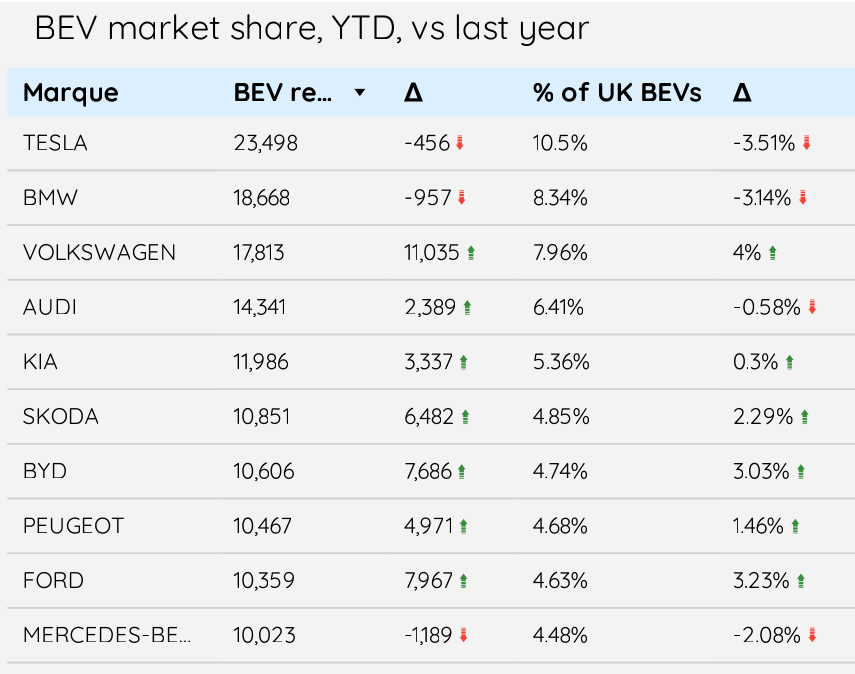One in four
Plus -- a tale of two carmakers and the ZEV mandate half term report card
Good morning. Six months ago, Ford was an EV also-ran. After missing its 2024 ZEV mandate targets, its electric vehicle strategy looked shaky. What a difference half a year makes. In the first six months of 2025, Ford’s battery electric vehicle sales up by a jaw-dropping 333%. This isn’t just growth; it’s a comeback story. But is it enough?
Welcome to the latest edition of Electric Car Count, your monthly update on electric car, van, motorbike and HGV sales in the UK - and the most up-to-date, free, comprehensive and detailed publication covering the EV transition in the UK. And, as we have been known to say before, what an update we have for you this month!
Scroll down for:
The news
How Ford got its EV groove back (and why Nissan didn’t)
The ZEV mandate half-term report: who’s top of the class, and who’s in detention?
Or you can…
Here is the news
One in four new cars is now fully electric. BEV registrations hit a record 24.9% of the market - the highest in 2025 and the highest June figure ever.
Electric van sales have almost doubled. Registrations in June were up a massive 89.9% on last year. One in every ten new vans sold last month was electric.
Batteries are the new normal: For the first time, two-thirds of all new cars registered in the UK have a battery of some kind (BEV, PHEV, HEV). The fossil fuel car is in terminal decline.
Enter Ford
Last month we highlighted how some well-known incumbent car brands are hitting the electric turbo button.
The headline act among these is Ford. They have transformed themselves from an EV laggard into a serious contender, boosting their H1 EV sales by 333% year-on-year. They are a case study in how a legacy giant can pivot when policy provides a clear direction.
But for every success story, there is a cautionary tale. In this month’s edition, it’s Nissan. They also missed their 2024 targets, but their story couldn’t be more different. Their BEV sales are down a shocking 69% so far this year.
This will cause a significant headache in the corner office of the UK government’s business department. Nissan will doubtless be knocking at the door asking for yet more concessions on the UK’s EV targets. These can only be given now at the cost of all those carmakers who are investing billions in meeting them, delivering products that save households and businesses thousands of pounds in running costs.
And what of Tesla? Last month we predicted the popping of champagne corks in Germany amid indications that VW or BMW would pip them to the top of the charts. But the bottles remain unopened in the cooler as Tesla’s sales received a boost that, while modest, was sufficient to see them hold their leading position in the UK electric car market.
ZEV Mandate: Half Term Report
The ZEV mandate’s headline target for cars is 28% this year. But, as regular readers know, carmakers can earn credits for selling cleaner petrol and hybrid cars, reducing the ‘real’ share of BEVs they need to sell. This month, that market-wide ‘real’ target sits at 22.06%.
At the halfway point, the league table is taking shape. VW Group, BMW, Geely (Volvo/Polestar), and BYD are all tracking comfortably ahead of their targets, building up a healthy surplus of credits.
But then there’s the naughty list. Several major manufacturers are deep in deficit. Nissan is at the bottom of the class with a shortfall of over 6,700 credits. They are followed by Stellantis, Toyota, and, despite their incredible growth, Ford.
That’s the crucial detail in Ford’s comeback story. They are growing incredibly fast, but from such a low base that they are still more than 2,700 credits short of their compliance target. It shows the sheer scale of the mountain that some manufacturers still have to climb. The ZEV mandate is working, and its effects are becoming clearer every month.
In April, the UK government announced new flexibilities for the ZEV mandate, which included the lowering of the floor on the effective ZEV sales target. In 2025 it will be reduced so low (to 2.8%) as to be effectively abolished.
We haven’t taken this new lower floor into account in our methodology yet because there is too much uncertainty around how the change will be implemented and the impact on the availability of ZEV mandate credits. It is still possible for the government to reform the mandate without significantly oversupplying the scheme with credits, whilst also giving those carmakers who need it a bit more flexibility in how they meet their targets. Want to know how? Drop us a line!
That’s it from us this month. As ever, there’s loads more in the full bulletin - so do click the button above to find out everything about vans, the ZEV mandate for vans, HGVs and motorbikes.
All the best,
Team New AutoMotive
You’re receiving this because you signed up to receive updates from us. Changed your mind? Not a problem, you can change your preferences or opt out of emails here.








